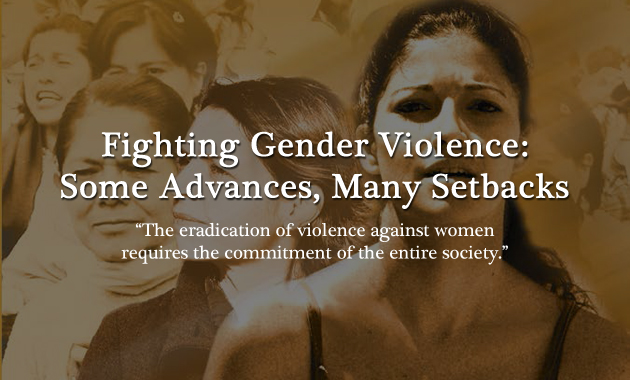- English
- Español
Media Center
Feature
-
The OAS fights against gender-based violence with MESECVI, a mechanism that evaluates the progress made by the countries of the Americas
-
The latest conclusion: “A cultural transformation is needed to eradicate gender-based violence against women”
November 23, 2015.
Latin America and the Caribbean is, according to the OECD, the region in the world that has made most progress in formally recognizing the rights of women. Twenty years ago, the states of the Americas made a great stride forward when they adopted, in the framework of the OAS, the “Inter-American Convention on the Prevention, Punishment and Eradication of Violence against Women”—also known as the “Convention of Belém do Pará.” Today, 32 of the 34 member states of the OAS have ratified the Convention and are thus committed to adopt “without delay” measures to protect women.
Reasons to celebrate are, however, few and far between, because the reality continues to be dramatic: according to ECLAC, 1,678 women—in the 17 countries of the region for which data exists— were murdered in 2014 because of their gender. Furthermore, according to the UN, 20 years ago, one in three women could expect to fall victim to violence at any given time in her life. Today, this disturbing figure remains unchanged.
What happened? That is the question that, in large part, the Second Report of the OAS Follow-up Mechanism to the Belém do Pará Convention (MESECVI) attempts to answer. Its conclusion is the translation into words of what the figures reveal: there are some advances, but setbacks still remain. “Progress in the region in the fight against gender violence has been uneven, and significant challenges still exist at all levels.”
Advances
“The eradication of violence against women requires the commitment of the entire society—the government, through education, development and security, as well as support mechanisms for women; the media (public and private); advertising agencies; the private sector; companies and associations; and, indeed, a main actor, civil society—to the task of questioning existing gender roles and proposing new pattern where both men and women can live in equality, justice, and without violence.”
Luis Almagro
OAS Secretary General
There are facts that reflect the efforts carried by states parties to comply with the Convention’s guidelines:
- 29 countries have adapted their national legislation to the provisions of the Convention.
- At the publication of the report, eight countries had enacted “second-generation” laws, which have eliminated or relegated to second place the concept of “intra-family” violence to also encompass the private and public spheres. In recent days, Peru joined this group.
- Nine states have laws that recognize the diversity of women, such as their ethnic origin, sexual orientation or disabilities, among others.
- Concrete steps taken include the establishment in many countries of shelters or havens for female victims of violence, the installation of emergency telephones, the availability of free legal assistance, as well as the creation of information and awareness campaigns on the subject.
Setbacks
Although the issue of violence against women has moved from being “invisible” to “a real and systematic problem,” too many difficulties persist:
- Only 8 of the 32 countries have comprehensive laws on violence against women, with a majority of laws still touching only on intra-family violence.
- There are still obstacles to assess the level of progress of states—lack of information on public funds allocated to the prevention, care, and punishment of violence.
- The rights of women to decide, exercise and control their sexuality and reproductive role, on an equal footing with men and free from discrimination, prejudice and violence, are not yet guaranteed.
Explanations
According to OAS Secretary General Luis Almagro, “the eradication of violence against women requires the commitment of the entire society—the government, through education, development and security, as well as support mechanisms for women; the media (public and private); advertising agencies; the private sector; companies and associations; and, indeed, a main actor, civil society—to the task of questioning existing gender roles and proposing new pattern where both men and women can live in equality, justice, and without violence.”
For the Technical Secretary of MESECVI, Luz Patricia Mejía, the limited progress in the area of protection of women’s rights is mainly due to the “lack of effective institutional responses, which in the end, beyond public condemnation, sends a permanent message of impunity to society.” Her assertion is supported by the level of social acceptance of violence by women themselves, which in countries covered in the report varies between 2.9% and 38.2% of the women’s population.
Another explanation—that of the President of MESECVI’s Committee of Experts, Diana González—is that some countries have undertaken to lower the rank level of entities responsible for the implementation of public policies for the protection of the rights of women, “which would result in a significant reduction of their operational power, their political and financial relevance and, hence, a setback in terms of the State’s response to women victims of gender-based violence.”
The difficulties to understand and fully address the issue of gender violence are varied in nature, but the President of the Executive Committee of CIM and Costa Rican Minister for the Status of Women, Alejandra Mora, considers that in order to make progress, it is urgent to improve statistics, “with data in each of the institutions, of women who access health care, of abused girls, regional data, to be able to have the perspective that allows for the design of a reality-based public policy.”
Reference: E-341/15



